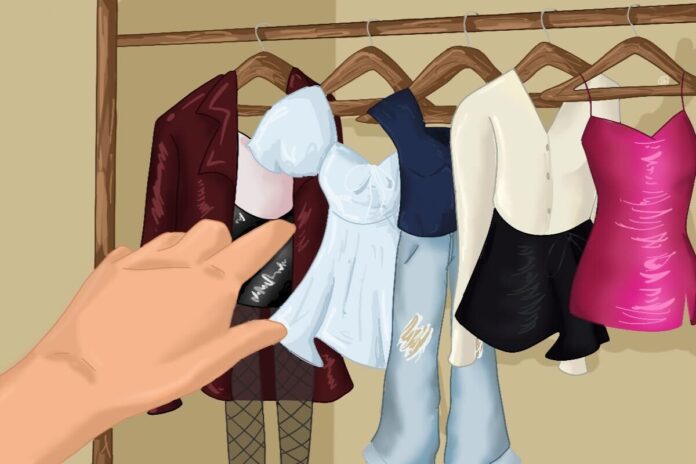Historically, fashion cycles in the Western world typically last about 20 years, with runways influencing seasonal trends. However, this traditional cycle is now shattered and digitally rearranged into micro-trends, rapidly gaining popularity online but becoming stale to consumers in weeks.
Micro-trends such as ballet-core, coastal-grandma, tomato girl and indie sleaze have all recently had their fleeting moment on TikTok and beyond. To reduce waste, some experts have encouraged style-conscious consumers to stop participating in these micro-trend cycles altogether.
But, pursuing sustainable fashion is more complicated than simply asking consumers not to take fashion inspiration from their daily scroll sessions. Although micro-trends are prevalent, they may not be the inherent cause of increased clothing waste.
Instead, leaders in the Canadian fashion scene say reducing clothing waste should be achieved by reimagining social norms rather than resisting micro-trends altogether.
The effects of overconsumption on textile waste and beyond
Sabine Weber, a professor at Seneca College specializing in sustainable fashion, said trends play an important cultural role in our society. Still, she cautioned consumers must be mindful of how trends are marketed.
“Fashion has the function to reflect the spirit of our times, but a lot of the trends are not really reflecting the spirit of our times, but are artificially made by the industry so that we consume more,” she said.
A 2016 study on consumer textile waste management conducted by Weber surveyed 410 people in Ontario, found fashion consumers were more likely to participate in reselling, swapping and take-back programs than non-fashion consumers. To distinguish “fashion consumers,” participants were asked about their fashion interests and shopping frequency.
“[Fashion consumers] know that clothes have a value, and they’d rather actually donate, swap or sell them than put them in the garbage,” Weber said.
This year, Weber published another study in collaboration with the University of Waterloo, where researchers analyzed textile waste from municipalities across Ontario. Approximately 10,700 items from 2019 to 2020 were graded on a scale from A to F based on their condition and fibre content.
Notably, this study found 65 per cent of the textile waste could have been reused and 21 per cent recycled.
“We were surprised that so many items were in perfect or good condition and could be reused,” she said.
A significant portion of the clothing found in good or perfect condition was from low-cost retailers such as Walmart and Joe Fresh. Researchers said they did not find luxury designer items.
“We didn’t find a Prada piece, but we found a lot of Walmart,” Weber said.

Given these findings, Weber said she doesn’t necessarily equate micro-trends to increased textile waste at the curbside. Although fashion consumers can find alternative ways to dispose of their unwanted clothes, they still may be overconsuming, she said.
Weber revealed that researchers found garments in the textile waste stream with price tags from second-hand retailers, such as Value Village. According to ThreadUP’s 2023 resale report, 10 per cent of the global apparel market is expected to be made up of second-hand apparel by next year.
“Right now, the social norm is you must have new garments, and you must follow every trend. We need a new norm that this is not fashion anymore. This is not in,” she said.
Weber said she recognizes fashion trends can be a powerful source of identity expression.
A fashion lover herself, she added she keeps a list of every new garment she adds to her wardrobe to ensure accountability.
“I have to control myself because I am one of those people who love fashion. I love clothes, I love textiles, and I am tempted to buy way too much.”
Encouraging fashion lovers to choose creativity over consumption
Ottawa-based influencer Alyssa Beltempo, 38, has been in the sustainable fashion scene for more than five years and has a platform of over 250, 000 subscribers on YouTube. She encourages her subscribers to choose “creativity over consumption” when getting dressed.
To Beltempo, there are several ways to participate in a trend without overconsuming. Because trends are so repetitive, she suggests breaking down a trend into its style elements versus focusing on single specific pieces.
“That is, to really break down fashion and stylistic things like garments and accessories into these elements of art and design, things like texture and silhouette,” she said.
Through her content on YouTube, Beltempo shows her subscribers how to reimagine the existing clothing pieces they own rather than buying new ones.
Similarly, Anika Kozlowski, an assistant professor at Toronto Metropolitan University who teaches sustainable design practices to small enterprises, said there is no definite causation between micro-trends and increased clothing consumption.
“We associate a new trend with paying for something new,” she said. “What if you already own something very similar that you could just modify?”
Personal style to curb over consuming trends
Beltempo emphasizes that tapping into a personal style can help someone follow trends without overconsuming them.
For example, Barbiecore, a viral fashion trend popularized by Greta Gerwig’s Barbie, has been praised for allowing women to embrace their inner child through its hyper-feminine aesthetic. The trend has recently dominated the fast-fashion space.
“We’re looking at Barbie. Oh my god, now everything is pink, but what if pink is actually your colour?” Beltempo said.

Beltempo said consumers should ultimately view micro-trend participation as less about competitive consumption, and instead consider if a trend feels genuine to their personal style.
“We can curb overconsumption through a lot of identity work and being more self-confident,” she said.
Alex Ure, the owner of second-hand and vintage clothing store Past Lives Thrift, said considering trends when choosing items to stock is often essential for business.
However, Ure said customers typically come in looking for specific clothing pieces. She said this may signal a more mindful form of consumption, given the power of personal style.
“When I’m selling something trendy, I always try to make sure that it’s a quality item and something that’s going to last,” Ure said. “Because it is vintage that I sell mainly, it’s usually a trend that is coming around for the second time.”
Due to this trend cycle, Ure began creating Reels on Instagram, comparing new trendy items to those in her store.
“[People] don’t realize the trends are coming from past items,” she said.
Where should the burden of clothing waste fall?
Kozlowski emphasized systemic issues, such as accessibility and a lack of consumer education, create clothing waste. She explains the burden should fall on policy-makers and fast-fashion corporations, not individuals.
“This is really where it’s the role of the government to just ensure that only good options are available to people,” she said.
Additionally, vintage and second-hand shopping requires consumers to have a luxury of time and is not realistic for everyone, Kozlowski said.
Although mindful that “sustainable” fashion options are also a matter of accessibility, Weber said the responsibility to initiate change is shared between the producer, consumer and the government.
“Solutions are always difficult because they’re demanding. Often, people use shopping as an outlet for frustration and a way to work on their egos without considering the impact of their consumption,” she said.
Given Weber’s recent research findings on textiles, there is a need for municipalities to adopt designated textile waste programs and disposal bans on textiles at the curbside, she said.
Markham, Ont. is one of Canada’s only municipalities with a designated textile recycling program. Markham has also banned textile waste at the curbside.
The City of Ottawa is developing a new solid waste master plan to present to council in early 2024. Phase 2 of the plan’s development report proposes exploring how existing textile recycling programs could be enhanced.
The City of Ottawa currently has a “Take it Back!” clothing donation bin program. However, the city’s waste explorer still lists throwing clothing waste into the garbage as an option.
Rachael Jones, the plan’s project manager, said the city’s current clothing bin recycling program lacks data on the back end, adding improvements are required to track the actual diversion rate of textiles.
“We don’t know what’s happening with that material at the end. Is it going to market? Is some of it going to a landfill?” she said.
Still, the plan does not recommend banning textiles from the garbage stream.
Beltempo says everyone, including those who are not fashion-conscious, can work toward mindful consumption by beginning to view their clothing as an extension of their values.
For example, one may value shopping locally for high quality or committing to personal style.
“If you have to get dressed, maybe think about it from the perspective of [being] more of a values-based thing, and it doesn’t even have to be slow fashion values.”
Ultimately, Beltempo encourages her subscribers not to get hung up on finding perfectly sustainable garments but to focus on working with pieces they already have.
“I shop my closet first, and I shop second-hand first because, I’m very lazy, and I would encourage other people to be lazy too,” she said. “[Let’s] just use what we’ve already got.”
Featured graphic by Alisha Velji/the Charlatan.






